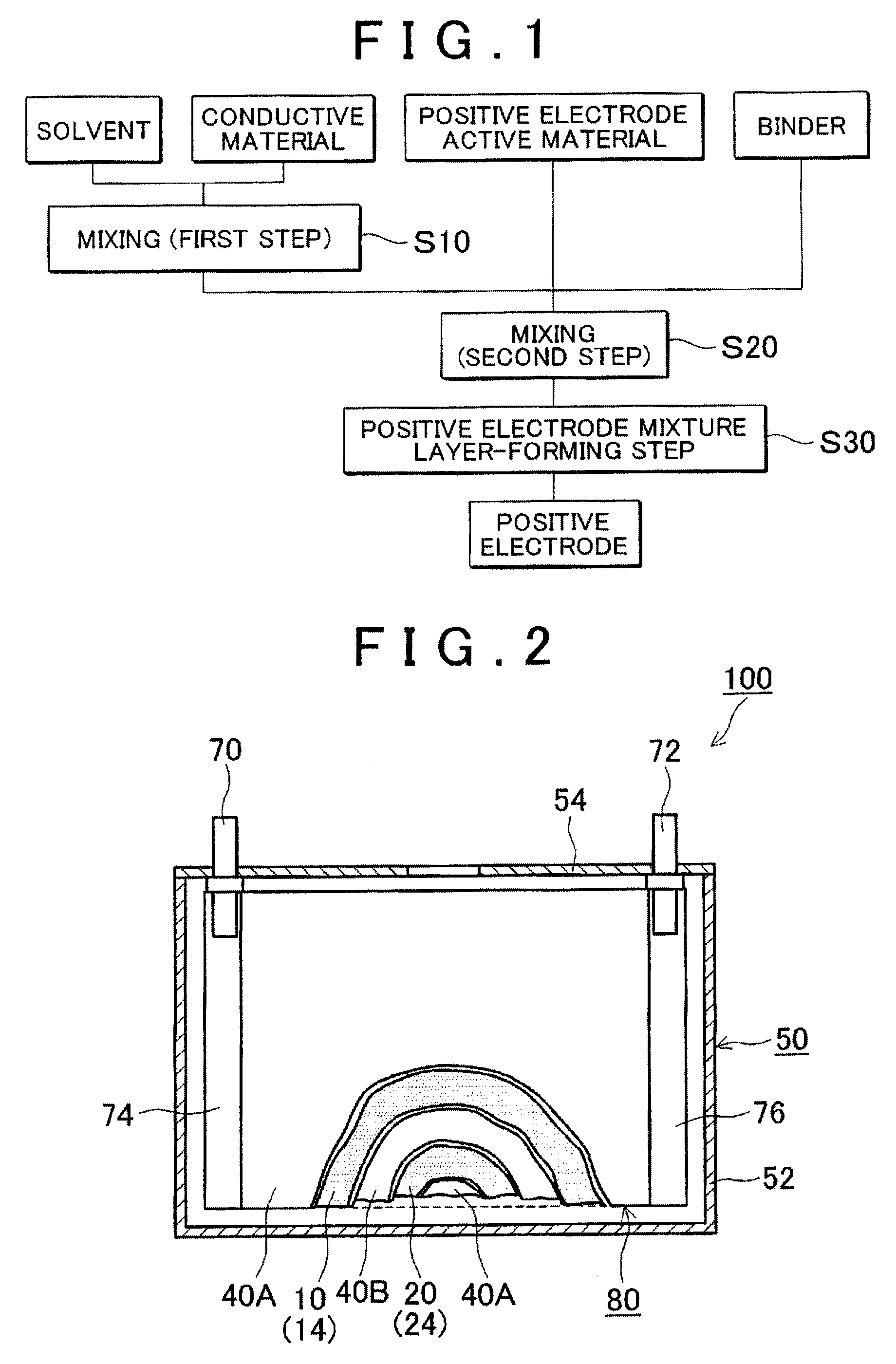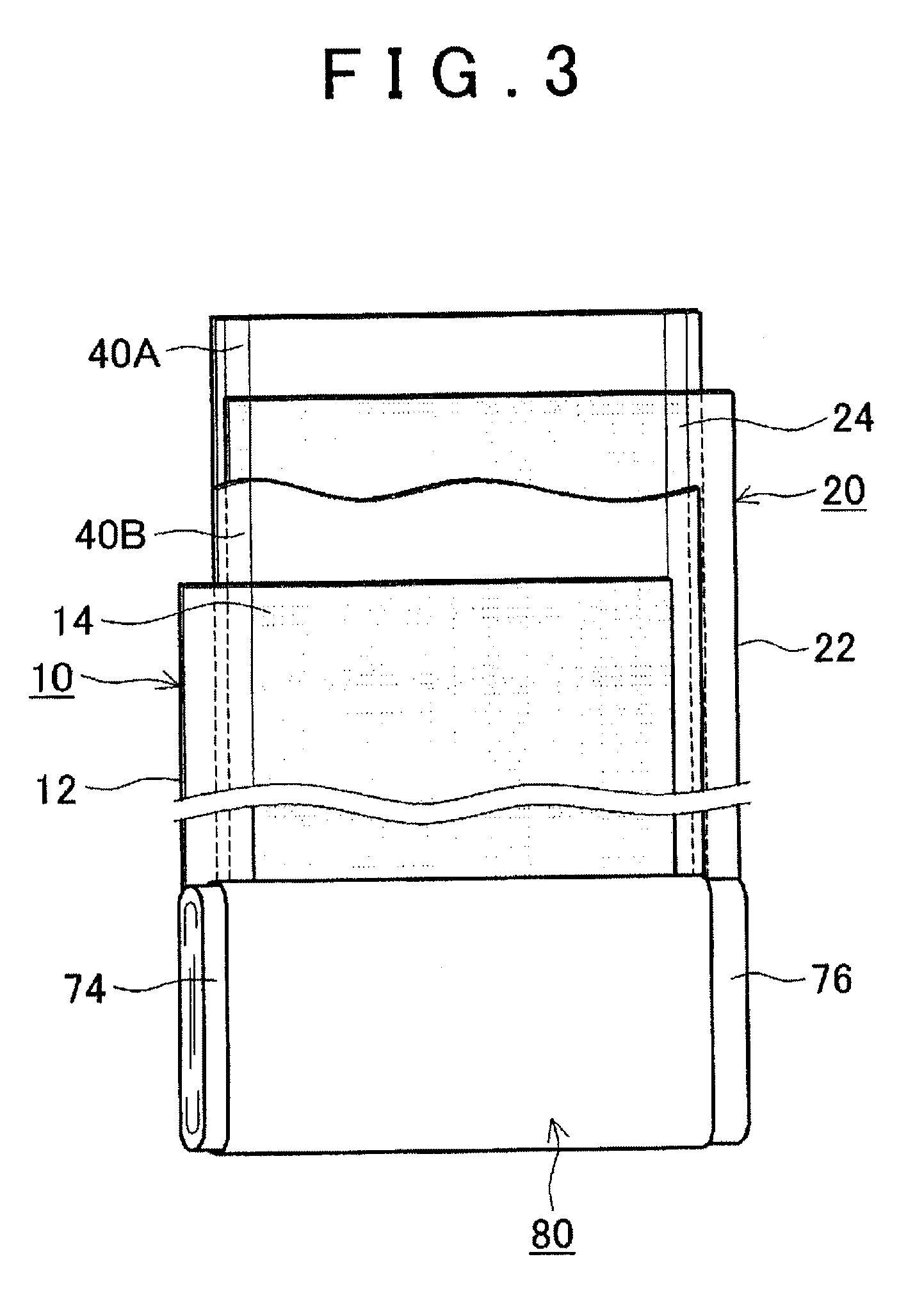Method for manufacturing lithium secondary battery
a secondary battery and lithium-ion battery technology, which is applied in the direction of cell components, final product manufacturing, sustainable manufacturing/processing, etc., can solve the problems of unfavorable uniform dispersibility in solvent, unfavorable temperature and/or drying time of positive electrode mixture layer-forming slurry, and particle disintegration, etc., to achieve excellent coating properties, excellent conductivity, and excellent coating properties of positive electrode current collectors
- Summary
- Abstract
- Description
- Claims
- Application Information
AI Technical Summary
Benefits of technology
Problems solved by technology
Method used
Image
Examples
example 1
[0068]In a high shear homogenizer (Type “MT-V45”, manufactured by KINEMATICS), 2.3 kg of N-methyl-2-pyrrolidone (NMP) as a solvent was put, in the solvent 215 g of acetylene black (AB; trade name: DENKA BLACK POWDER, manufactured by DENKI KAGAKU KOGYO KK) was added as a conductive material, and a mixture was stirred for 15 min at the shearing speed of 30000 s−3 to disperse the AB in the solvent (first step). Here, a particle size distribution of the conductive carbon fine particles contained in the solvent was measured by a laser diffraction particle size analyzer (type: “MT3000”, manufactured by MicroTrack Co., Ltd.). Obtained results are shown in corresponding places of Table 1. In the Table, D10, D90 and D90 / D10, respectively denote a particle size at 10% accumulation, a particle size at 90% accumulation, and a ratio (D90 / D10) of the particle size at 90% accumulation (D90) and the particle size at 10% accumulation (D10).
[0069]A LiNi1 / 3Co1 / 3Mn1 / 3O2 powder (NCM; a particle size at ...
example 2 to example 9
[0070]Except that, in the first step, a total stirring time was set to 15 min that is the same as that in example 1 and a timing for charging the AB (that is, a time until the AB is added from the start of stirring) was changed, in a manner similar to that of example 1, positive electrode mixture layer-forming slurries were prepared. The smaller the number of examples is, the faster the timing for charging the AB is, that is, the longer the stirring time after the AB was added is. Also in each of Examples 2 to 9, in a manner similar to that of example 1, a particle size distribution in the first step and the viscosity and a particle size in the second step were measured. Obtained results are illustrated in corresponding places of Table 1.
example 10
[0071]Except that, in the first step, with a bead mill (type name: “LABSTAR LMZ06”, manufactured by Ashizawa FineTech Ltd.) and with beads of φ0.5 mm as a crushing media, the mixture was stirred for 15 min to disperse AB in a solvent, in a manner similar to that of example 1, a positive electrode mixture layer-forming slurry was prepared. Also of Example 10, in a manner similar to that of example 1, a particle size distribution in the first step and the viscosity and a particle size in the second step were measured. Obtained results are illustrated in corresponding places of Table 1.
PUM
| Property | Measurement | Unit |
|---|---|---|
| particle size | aaaaa | aaaaa |
| particle size | aaaaa | aaaaa |
| particle size | aaaaa | aaaaa |
Abstract
Description
Claims
Application Information
 Login to View More
Login to View More - R&D
- Intellectual Property
- Life Sciences
- Materials
- Tech Scout
- Unparalleled Data Quality
- Higher Quality Content
- 60% Fewer Hallucinations
Browse by: Latest US Patents, China's latest patents, Technical Efficacy Thesaurus, Application Domain, Technology Topic, Popular Technical Reports.
© 2025 PatSnap. All rights reserved.Legal|Privacy policy|Modern Slavery Act Transparency Statement|Sitemap|About US| Contact US: help@patsnap.com



